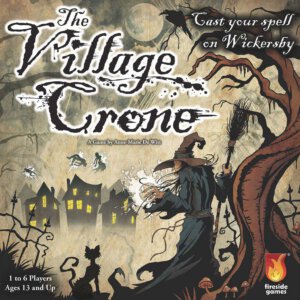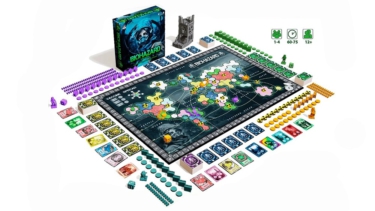Publisher: Fireside Games
Designer: Anne-Marie DeWitt
Year: 2015
Genre: Worker placement game of spell casting
Players: One to six players
Ages: 13+
Playing Time: Around 90 minutes
MSRP: $49.95
A look at The Village Crone with Anne-Marie DeWitt at Gen Con 2015
The premise of The Village Crone is that each of the players represents an old, witchy hag who is vying to become the self-appointed crone of the village of Wickersby – thus the title of the game – and to do so must complete thirteen points worth of Witch’s Scheme cards. The Schemes vary from one to three in victory point value. Normally the points of the Schemes correspond with the number of steps involved to complete the Scheme. One condition for a single point, two conditions for two points, and so on.
If you’ve checked out the interview above I did with Anne-Marie DeWitt at Gen Con then you’ll have seen a good representation of the components in the box. As with most Fireside titles the component quality is good (solid counters, good card stock, etc) although I must say the art, while effective enough, surely won’t knock anyone’s socks off. Just a quibble and the art certainly has no effect on gameplay.
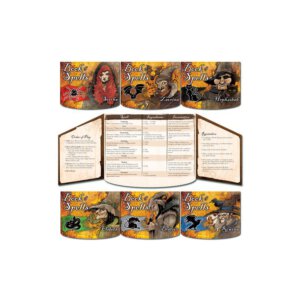
Here are the eight spells:
Conjuring – Players begin with three familiars and casting this spell can add an additional familiar to your supply. You can have a maximum of five.
Love – Casting this causes two villagers to fall into or out of love.
Summoning – This spell allows the player to move one villager or one familiar from one location directly to another location where you already have a familiar present.
Switching – This spell allows you to switch locations between two familiars or villagers.
Transformation – You can turn a villager into a frog or a frog back into a villager.
Fortune – Use this spell to draw three Ingredient cards from the Tithe Barn.
Binding – This spell prevents anything from moving into or out of a location and also prevents any spells being cast on that location. Binding can also be cast to unbind a location.
Protection – Simply block another spell from being cast.
Spells require the use of Ingredients and this is how the familiars mainly come into play. Each turn you receive two ingredient cards from the location where you presently have a familiar. There are four types of Ingredients which are available at specific locales: Fire from the Forge, Silver from the Lord’s Manor, Soil from the Farm (they’re growing soil?!?!?!), and Flour from the Mill. Each of the Ingredient decks also contain three Eye of Newt cards which are used as wildcards in spell casting. Two other locations are present as well with the Village Green and Tithe Barn. Each of the six villagers begins the game specifically in one the locations too.
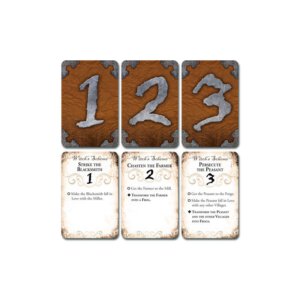
Tithe – Each player has to discard an Ingredient card of their choice to the Tithe Barn unless they have a familiar at that location.
Move and Cast Spells – Beginning with the first player the witches take turns moving familiars and/or villagers while also casting spells. Each turn players have six movement points they can spend however they please so they can conceivably move a familiar three spaces – movement is orthogonal only and never diagonal – then cast a spell and follow that up by moving a villager another three spaces. Players can cast as many spells as they like as long as they have the required Ingredient cards. Protection spells can also be cast by other players even when it isn’t their turn.
During this step you also complete your Witch’s Scheme. The Schemes require certain conditions to be met before you can complete them. The conditions could be active – in which you have to be the player who brought about that condition during your turn – as well as passive whereas someone else has done the dirty work for you already. The more conditions the more VPs the Scheme is worth. You can also complete Schemes during someone else’s turn (although this can be tricky since the active conditions of any scheme have to have been met by you) at a cost of one silver. Once a Scheme has been completed the player who completed it may choose another Scheme card from one of the decks of their choosing. Schemes can also be discarded and replaced at the cost of one silver.
Harvest – Simply enough each player draws two Ingredient cards for each of their familiars in one of the four resource locations. If a player doesn’t have a familiar at a resource spot then they draw two cards from the Tithe Barn stack.
Move the Broom – The turn ends and the Broom token moves clockwise to the next player making that person the first player in the upcoming turn.
The game ends once a player has completed thirteen points worth of schemes. In case of a tie the player who completed the fewest Schemes in order to reach thirteen points is the winner.
Now on to the brass tacks and my thoughts about The Village Crone overall. Well… This is where it gets tricky. As a two or three player game, just possibly with up to four players, this is a fairly fun experience. I like the fact you have to use movement points in order to traverse the village with the familiars and villagers 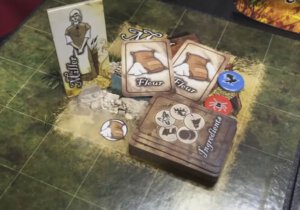
Major problems do begin to arise as you add more players to the mix. Personally I found trying to play The Village Crone as a six player game led to the proceedings bogging down into what was essentially an unmitigated mess. Since there is so much randomness built into the design by way of the Witch’s Scheme cards, and only six villagers to work with, it begins to become nigh impossible to complete any of the three point Schemes if you’re playing with a full complement of gamers. Multiple turns worth of work by any player can be undone by even the most innocuous decision of another. Also, since you don’t know what Schemes your opponents are looking to complete, there’s no way of figuring out what you should be doing to throw a wrench into other players’ works while aiming to complete your own Schemes. In other words those who like to come up with a plan or strategy are sure to be sorely disappointed by the fact they’re in a constant state of gaming within the confines of what’s directly in front of their eyes at any given moment. The optional rules do alleviate some issues (keeping Scheme cards face up for all to see as an example) but don’t erase the problems completely.
The rules as written also require the players to recite the incantations every time they cast a spell and I’ll be the first to tell you that flew for about five minutes around these parts. What originally comes across as sort of funny becomes rather grating on the nerves once you’ve heard the same two sentences repeated for the tenth time. I’m going to guess the vast majority of gamers who tackle this title will be disregarding the recitation aspect straight away as well.
In my opinion the sweet spot for The Village Crone is three players. This way you avoid the pitfalls more players bring to the design and you can complete a full game in a relatively moderate amount of time. Plus there tends to be a lot less of the players stepping on each other’s toes, so to speak.
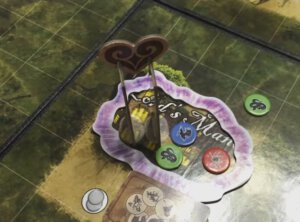
I really love what Justin and Anne-Marie DeWitt have done to date with Fireside Games but I have to say I just don’t love The Village Crone. I think it’s fairly good with two or three at the table but the bottom begins to fall out more and more as the number of players increase. Truly, this is one of those games where the people you game with are really going to determine everyone’s enjoyment. While serious and strategically inclined gamers will balk at the amount of randomness built into the design (which prevents even a moderate plan of attack), those who are into lighter fare will probably be turned off by the good deal of mental bookkeeping and time investment required to play the game.



